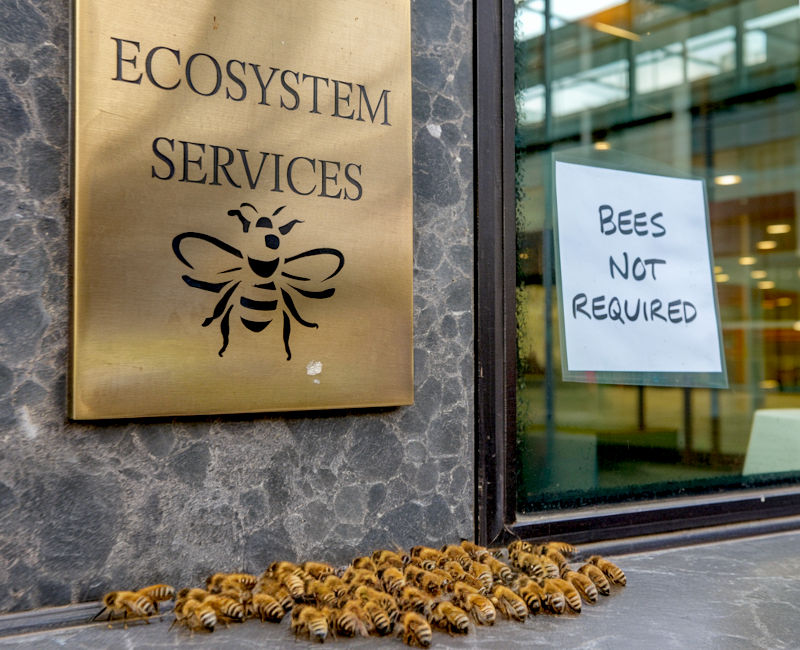Pete Jorgensen
Plant Science & Horticulture
How the Cult of Capitalism Consumes Coherence in Conservation
Those wishing to conserve global biodiversity in the 21st century may be facing an impossible task. To conserve means to protect from harm, yet human activity continues to degrade the natural environment at an astonishing pace. Reported population levels of mammals, birds, fish, reptiles, and amphibians fell by 60 percent between 1970 and 2014 (Grooten & Almond, 2018). Over 30% of the world’s protected areas face intense pressure from human activities (Jones et al., 2018). CO2 emissions continue to rise, and climate change may already be out of control (Brown & Caldeira, 2017). Massive declines in insect populations warn of an ‘ecological armageddon’, although it is not yet clear whether this is truly a global phenomenon (Leather, 2018; Sánchez-Bayo & Wyckhuys, 2019). Between 2017 and 2018, the Amazon rainforest saw its worst year of deforestation in over a decade (BBC, 2018). The convention on biological diversity (CBD) appears set to fail most of the 2020 Aichi targets set at COP 10 (Wemaere et al., 2018). Any faith that science and technology will solve these problems, elides the facts of our recent history.
Economic activities are directly or indirectly responsible for most, if not all, of the conservation issues we face. The concept of ecosystem services (ES) first emerged during the early 1980s as a means of promoting the economic value of nature in policy discourse at a time when neoliberalism was in the ascendant (Mooney & Ehrlich, 1997). Since then, support for ES has increased. In 2005, the WRI’s ‘Millennium Ecosystem Assessment’ (MEA) injected ES into the arena of mainstream international policy (Reid, et al., 2005). However, ES have yet to be widely implemented as a system of governance and remains a hotly debated topic. I aim to expand on some aspects of this controversy, not only as a means of exploring ES, but also as a heuristic for unveiling the true challenge of contemporary conservation issues.

The rise of the arboretum coincides with the beginning of proliferation of industrial-scale destruction of natural tree cover.
As Joni Mitchell sang, 'They took all the trees put 'em in a tree museum'.
The MEA defines ES as “the benefits people obtain from ecosystems”. Evaluation can be quantitative or qualitative, but there is an increasing trend towards financial measurement; long-standing proponents believe this is needed now more than ever (Costanza et al., 2014). The intention seems noble - by quantifying the value of natural processes, policymakers and stakeholders will realize the value of biodiversity and give it due prominence in decision-making and budget allocation. Costanza et al. (2014) suggest global ES have an annual value of between $125-145 trillion - a big number, but how useful is it? Monetized ES is proposed as a metaphor - actual payments for ES (PES) are only intended to be used in appropriate circumstances. This seems, at best, naive. Capitalism does not recognize any epistemological difference between price and value; how then can price operate as a metaphor for value?
Financialized ES may be a counter-productive means of communicating the value of nature to the public. Some are outraged by attempts to monetize nature (Clark et al., 2000) and many don’t seem to know what ES really means, nor do they think it is a useful concept (Thompson et al., 2016). Public confusion is unsurprising given that there is much disagreement in the academic community about what ES are or what they should be used for. Despite this, the NCC (Natural Capital Committee, 2014) have attempted to price things like the aesthetic value of rivers and mountains. Monbiot (2014), calls this “gibberish”. The methodology does appear to be unsound. ES are often evaluated in monetary terms through contingent value (CV). Members of the public are asked what they would be prepared to pay (or forego) for something which is not ordinarily an economic object. For example, Lo & Jim (2015) asked respondents how much they would be willing to pay to protect culturally important urban trees. Their study examined the reliability of willingness to pay as a means of establishing CV. Results were mixed and inconsistent - some participants refused to give a value, others gave very high values (unaffordable in reality) as a form of protest. Hausman (2012), a professor of economics from MIT, considers the CV method to be so arbitrary and unreliable as to be ‘hopeless’.
ES is a heterogenous paradigm, and it must be acknowledged that various non- monetary means of evaluation are employed. Cultural ES seem particularly resistant to measurement in financial terms. For example, a qualitative study of Cornish fishermen highlighted how a holistic narrative is crucial for understanding the complexities of sense of place and occupation (Urquhart & Acott, 2014). The importance of culture, connection to the natural environment, and meaningful livelihoods, were all outlined. Historically, these things have been studied and discussed outside the ES frame (Tuan, 1975; Morse & Weiss, 1955). Urquhart & Acott (2014) conclude that they do not understand how the perspectives gained could fit into an ES method of managing fisheries, yet they do not seem to doubt that ES is the best framework for their findings. This suggests that the ES paradigm inhibits alternative ways of thinking, entrenching its neoliberal ontology regardless of context (Silvertown, 2015). Indeed, UNEP’s 2011 report - ‘Towards a Green Economy’ - suggests that the modern environmental crisis is merely the symptom of a dysfunctional market in need of better management and investment (Arsel & Büscher, 2012). The chairman’s introduction to the 2014 NCC report is especially revealing, “…the environment is part of the economy and needs to be properly integrated into it so that growth opportunities will not be missed.” (Natural Capital Committee, 2014). The NCC appears to have ignored three decades of prominent discourse emphasizing the fact that the economy, as a human construct, is a subset of the environment.
Some believe that adopting the terminology of economics (natural capital, ecosystem services) will broaden the ecological debate, incorporating entities that have historically been viewed as enemies of conservation (Lele et al., 2013). However, it might more accurately be described as acquiescence to the dominant neoliberal mentality and capitulation to the power of finance. This has not been a deliberate surrender but an attempt at pragmatism that fails to recognize the nature of capitalism, especially neoliberalism. There is a dearth of evidence to suggest that proponents of capitalist economics have profoundly altered their approach to, or opinion of, the environment in the way that ecologists and environmentalists have compromised theirs (Lele et al., 2013). In 2018, the number one threat CEOs were most anxious about was ‘over- regulation’ (PwC, 2018). Other threats such as tax hikes and terrorism were perceived as more salient than the climate and environment which, for four out of seven global regions, didn’t even appear among their top ten concerns. It seems the ES ‘trade-off’ has been rather one-sided to date. This should not be surprising. Gross inequality, instability, exploitation and degradation of natural resources have dogged capitalism throughout its history; far from being issues capitalism can solve, they are an unavoidable outcome of its logic (Piketty, 2014; Magnuson, 2018; Clark et al., 2018).
Supporters of ES might also consider the failings of sustainable development (SD). Like ES, SD emerged during the ascendancy of neoliberal economics (Brundtland, 1987). Like ES, SD was, and remains, an ambiguous, contentious, and confusing idea (Dobson, 1996). The same undemocratic global institutions, such as the UN and World Bank, pushed both ideas (SD now appears to be morphing into ‘sustainable intensification’ and ‘green growth’). Yet private capital will only adopt superficial environmental concerns to serve its own ends. An analysis of the reliability of sustainability reports found that businesses attempt to hide negative results through a proliferation of confusing information and the adoption of opportunistic greenwashing (Calabrese et al., 2017). Perhaps a more damning example of SD’s failings can be revealed through the case of British multinational Carillion plc. In 2017, the corporation won a prestigious award emphasizing their commitment to SD (UK Construction Online, 2017). An ISO-accredited auditor published a report in 2017 applauding Carillion’s sustainable credentials - one of which was the strength of their finances (Carillion, 2017). Yet within six months the company had collapsed, leaving a huge bill for the British taxpayer (Prior, 2017; Burgess, 2018). It is clear that the financialized metaphysics of capitalist economics is incapable of providing a stable foundation on which to build a sustainable future; economic priorities will always dominate markets and the actors who operate within them, eclipsing ecological and social concerns (Magnuson, 2018). An example of this, pertinent to ES, comes from a case in Finca Santa Fe, Costa Rica. Native bees providing pollination services for a coffee plantation were valued at $60 000 per annum (McCauley, 2006). The coffee price dropped, and growers replanted with more lucrative pineapple crops. Pineapples require no pollination - the bees became worthless; like Carillion’s workers, those ecosystem servants suddenly found themselves disposable.

The concept of ecosystem services turns the natural world into a disposable resource for the nihilistic utilitarianism of capitalism
Like SD, ES may have success stories, but they are likely to be pyrrhic victories. The nature of change required in global society is vastly more radical than supporters of the ES framework seem willing, or able, to acknowledge. ES is not a pragmatic tool but part of an ideological process that commodifies nature. It paves the way for capital to reproduce itself by feeding on ecosystem markets and perhaps subsequently for increasingly substituting life with technology (Fitter, 2013). The conservation conversation is being starved of the language of values and emotions that express true reverence for nature – love, beauty, respect, wonder, awe, and humility – these values need to be stimulated, not subdued. Discussions about financialized stocks, and flows of ES, did not lead to the introduction of the plastic bag tax in the UK. The regulation was implemented after film-makers produced compelling and emotive images communicating the beauty and joy of living beings and causally connecting their suffering to undesirable cultural behaviour. Reducing plastic bag use might seem like a drop in the ocean, but it shows that public support, and political will, for change, can be stimulated quickly if the need is communicated effectively and emotively.
The real challenge for conservation in the 21st century is to recognize that it is one of deep cultural values, or a lack thereof. Degradation of nature is fuelled by the dominance of capitalist instrumentalism and its accompanying consumerist mentality. The historical development of the modern neoliberal ontology is extensive; it has not only colonized language and discourse, but also hearts and minds (Mirowski & Plehwe, 2009; Slobodian, 2018). Captives of this normative outlook may be unable to see it. However, seen or unseen, the hungry ghost of capital will seek to reproduce itself by any means possible. It commences through a method of individuation and categorization that co-opts all objects, concepts, and processes, into a quantitative amoral framework (Fairclough, 1999). Connectivity, complexity, and relationships are destroyed or ignored (Büscher et al., 2012). Isolated, all beings must justify the worthiness of their existence on a balance sheet. This is already the case for many human beings. ES is becoming the framework through which neoliberal capitalism legitimizes decisions about which non-human life to support (the temporarily productive) and which to let die (Fletcher, 2018). The danger of this attitude is summed up by neoliberal fantasist (Friedman, 2008), “…there is only one thing bigger than Mother Nature, and that is Father Profit”. There is an obvious and very undesirable outcome to the logic in Friedman’s gender-biased assertion. Surely, it would be more productive to encourage a positive public discourse that transcends instrumentalism not one devalued to the failing modality of soulless utilitarianism? If so, it will require the definancialization of language, and the reframing of discourse and public debate. Our contemporary ecological tragedy cannot be halted by a conservation movement that becomes another faction in the cult of cynical mechanistic economics: “…envision yourself strolling near a peaceful coastal marshland? What do you see? Birds and bunnies? ... I see dollars.” (Ruhl, 2015).

The zombie ontology of natural capital
Arsel, M. & Büscher, B., 2012. Nature™ Inc.: Changes and continuities in neoliberal conservation and
market‐based environmental policy. Development and Change, 43(1), pp. 53-78.
BBC, 2018. Amazon rainforest deforestation 'worst in 10 years', says Brazil. [Online]
Available at: https://www.bbc.co.uk/news/world-latin-america-46327634
[Accessed 09 February 2019].
Brown, P. T. & Caldeira, K., 2017. Greater future global warming inferred from Earth’s recent energy
budget. Nature, 552(7683), p. 45.
Brundtland, G. H., 1987. Report of the World Commission on environment and development:" our
common future.", New York: United Nations.
Burgess, K., 2018. Carillion’s board: misguided or incompetent?. [Online]
Available at: https://www.ft.com/content/2095beca-fb8b-11e7-a492-2c9be7f3120a
[Accessed 01 17 2018].
Büscher, B. et al., 2012. Towards a Synthesized Critique of Neoliberal Biodiversity Conservation.
Capitalism nature socialism, 23(2), pp. 4-30.
Calabrese, A., Costa, R., Ghiron, N. L. & Menichini, T., 2017. To be, or not to be, that is the Question. Is
Sustainability Report Reliable?. European Journal of Sustainable Development, 6(3), pp. 519-526.
Carillion, 2017. Sustainability Report 2016, London: Bureau Veritas UK Limited.
Clark, B., Auerbach, D. & Longo, S. B., 2018. The bottom line: capital’s production of social inequalities
and environmental degradation. Journal of Environmental Studies and Sciences, 8(4), pp. 562-569.
Clark, J., Burgess, J. & Harrison, C. M., 2000. I struggled with this money business”: respondents’
perspectives on contingent valuation. Ecological economics, 33(1), pp. 45-62.
Costanza, R. et al., 2014. Changes in the global value of ecosystem services. Global environmental
change, Volume 26, pp. 152-158.
Dobson, A., 1996. Environment sustainabilities: An analysis and a typology. Environmental Politics, 5(3),
pp. 401-428.
Fairclough, N., 1999. Global capitalism and critical awareness of language. Language awareness, 8(2),
pp. 71-83.
Fitter, A. H., 2013. Are ecosystem services replaceable by technology?. Environmental and Resource
Economics, 55(4), pp. 513-524.
Fletcher, R. et al., 2018. Natural capital must be defended: green growth as neoliberal biopolitics. The
Journal of Peasant Studies, pp. 1-28.
Friedman, T. L., 2008. Hot, flat, and crowded: why the world needs a green revolution-and how we can
renew our global future. 1st ed. London: Allen Lane.
Grooten, M. & Almond, R. E. A., 2018. Living Planet Report 2018: Aiming Higher, Gland: WWF.
Hausman, J., 2012. Contingent valuation: from dubious to hopeless. Journal of Economic Perspectives,
26(4), pp. 43-56.
Jones, K. R. et al., 2018. One-third of global protected land is under intense human pressure. Science,
360(6390), pp. 788-791.
Leather, S. R., 2018. “Ecological Armageddon”–more evidence for the drastic decline in insect numbers.
Annals of Applied Biology, 172(1), pp. 1-3.
Lele, S. et al., 2013. Ecosystem services: origins, contributions, pitfalls, and alternatives. Conservation
and Society, 11(4), pp. 343-358.
Lo, A. Y. & Jim, C. Y., 2015. Protest response and willingness to pay for culturally significant urban trees:
Implications for Contingent Valuation Method. Ecological Economics, Volume 114, pp. 58-66.
Magnuson, J., 2018. The Neoliberal Oxymoron of Green Capitalism. In: R. Westra, ed. Financing the
Apocalypse: Drivers for Economic and Political Instability. Cham: Palgrave Macmillan, pp. 287-306.
McCauley, J. D., 2006. Selling out on nature. Nature, 443(7107), pp. 27-28.
Mirowski, P. & Plehwe, D., 2009. The Road from Mont Pèlerin. 1st ed. Cambridge: Harvard University
Press.
Monbiot, G., 2014. "The Pricing of Everything" by George Monbiot. [online video]
Available at: https://www.youtube.com/watch?v=ni1tX0bpTR8
[Accessed 29 January 2019].
Mooney, H. A. & Ehrlich, P. R., 1997. Ecosystem Services: A Fragmentary History. In: G. C. Daily, ed.
Nature's Services: Societal Dependence On Natural Ecosystems. Washington: Island Press, pp. 11-19.
Morse, N. C. & Weiss, R. S., 1955. The function and meaning of work and the job. American Sociological
Review, 20(2), pp. 191-198.
Natural Capital Committee, 2014. The state of natural capital: restoring our natural assets, London: HM
Government UK.
Piketty, T., 2014. Capital in the 21st Century. 2nd ed. Cambridge: Harvard University Press.
Prior, G., 2017. Carillion profit warning unearths £845m contract black hole. [Online]
Available at: http://www.constructionenquirer.com/2017/07/10/carillion-profit-warning-unearths-
845m-contract-black-hole/
[Accessed 20 01 2018].
PwC, 2018. 21st CEO Survey: The Anxious Optimist in the Corner Office, London:
PricewaterhouseCoopers.
Reid, W. V. et al., 2005. Millennium Ecosystem Assessment. Ecosystems and human well-being: synthesis,
Washington: World Resources Institute.
Ruhl, J. B., 2015. In defense of ecosystem services. Pace Environmental Law Review, Volume 32, pp. 306-
335.
Sánchez-Bayo, F. & Wyckhuys, K. A., 2019. Worldwide decline of the entomofauna: A review of its
drivers. Biological Conservation, Volume 232, pp. 8-27.
Silvertown, J., 2015. Have ecosystem services been oversold?. Trends in ecology & evolution, 30(11), pp.
641-648.
Slobodian, Q., 2018. Globalists: The End of Empire and the Birth of Neoliberalism. 1st ed. Cambridge:
Harvard University Press.
Thompson, J. L. et al., 2016. Public Understanding and Trust in conservation science and ecosystem
services. Frontiers in Communication, 1(3), pp. 1-9.
Tuan, Y. F., 1975. Place: an experiential perspective. Geographical review, 65(2), pp. 151-165.
UK Construction Online, 2017. Carillion receives Queen’s Award for Enterprise. [Online]
Available at: https://www.ukconstructionmedia.co.uk/news/carillion-receives-queens-award-
enterprise/
[Accessed 05 February 2019].
Urquhart, J. & Acott, T., 2014. A sense of place in cultural ecosystem services: the case of Cornish fishing
communities. Society & Natural Resources, 27(1), pp. 3-19.
Wemaere, M., Maljean-Dubois, S., Rankovic, A. & Laurans, Y., 2018. What legal options for the
international agreement on biodiversity in 2020? A first look at the possibilities, Paris: IDDRI.